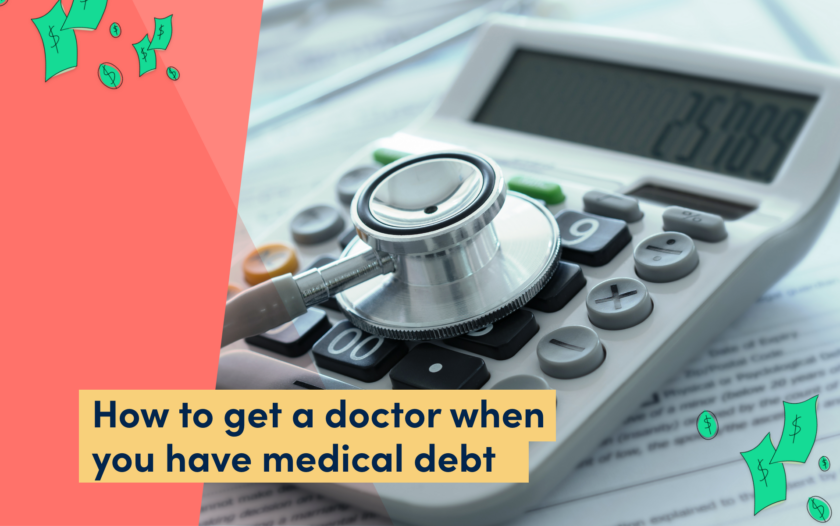Help! I Need a Doctor but I Have Medical Debt
About Anouare
Anouare is a seasoned writer, editor and content strategist who started her career as a lifestyle journalist before stepping into leadership roles at publications such as AskMen and Goalcast. From editorial strategy to content marketing and project-management, she has tackled various challenges in digital media and discovered her passion for mentoring others in the process. She loves a good money mindset book and believes you can create your dream lifestyle by being yourself.
Read full bio
At a Glance
Personal medical debt in the U.S. has reached alarming heights. According to health policy research organization KFF, Americans owe at least $195 billion in medical debt. That debt can be hard to quantify because it can take different forms, from hospital bills and credit card balances to loans and money owed to friends and family. A KFF survey revealed that 41% of adults have debt caused by medical or dental bills.
If you contrast that with the fact that healthcare in the U.S. can be expensive and that many people lack proper insurance coverage, it’s easy to see how the average American can be one medical emergency away from ending up in debt.
If you find yourself in that situation and need to see a doctor, it’s crucial to seek medical attention despite financial constraints. Here’s how to navigate the situation.
Assessing your medical debt situation
Knowledge is power. Even though it can feel stressful and overwhelming, the best thing you can do is start by assessing your medical debt situation. Gather all your medical bills and records. Verify the accuracy of bills by asking for itemized bills from your healthcare provider if needed, where you can see exactly what you were charged for. Determine the extent of your financial hardship by assessing your monthly budget and expenses against your total medical debt and other debt.
Now you have a realistic view of the challenges you face, which can help you in your quest to find solutions.
4 Steps to take when you have medical debt and need a doctor
Getting a doctor when you already have medical debt in 2023 can be challenging, but know that doctors have a duty to treat regardless of your financial situation – at least when it comes to emergency care. Now here’s the tricky part: Medical debt can be an issue if a healthcare provider requires upfront payment or proof of insurance for medical services. The four steps below can help you protect yourself and get access to care.
1. Check past medical bills for accuracy and dispute any errors or charges that shouldn’t be there. Don’t let yourself get intimidated by debt collectors. You have the right to ask them to verify the accuracy of debt and provide you with more information about the bill that’s being collected. If the medical bill is yours and it’s accurate, they are allowed to sue you, so it’s important to address the situation head-on. Ask that they only communicate with you in writing to keep a paper trail of communication.
2. You can always negotiate with healthcare providers or enter a debt management plan. Hospitals offer financial assistance programs, reduced payment plans and debt forgiveness. You may have more options than you think, and your state or local social services can help you explore them.
3. Know your rights and protections. The No Surprises Act, which applies to any treatments you received starting January 1, 2022, means that you shouldn’t be receiving unexpected bills for emergency services from out-of-network providers. If you are uninsured or are paying for care without using your insurance, your provider needs to give you a “good faith” estimate of your anticipated medical bill. If the bill ends up being $400 or more above that estimate, you can dispute the charges.
4. Seek low-cost or free health care options to get access to a doctor without breaking the bank. There are community health centers, free clinics and charitable organizations that work to offer health care services to low-income or uninsured patients. You may also qualify for Medicaid or other public health insurance programs, so do your research.
Managing your medical debt responsibly
While you shouldn’t let medical debt get in the way of seeking more care when needed, managing your debt responsibly can help you feel more in control of your financial future. Budgeting and financial planning is key here – seek the help of a financial advisor to come up with a plan.
You’ll also want to create a realistic debt repayment plan that is aligned with your monthly income and expenses. Aiming to make huge debt payments can backfire if other emergencies come up, so make sure you create an emergency fund as part of your plan.
Look into debt consolidation and settlement options that can reduce the total amount of debt that you owe as well as the interest that you’re paying on it. Finally, always try to negotiate settlements with debt collectors – you can even look into medical billing advocates who can negotiate with debt collection agencies on your behalf.
Bottom line
Medical debt isn’t fair. If you find yourself in that situation, don’t despair – you have rights and options. Regardless of your financial challenges, it’s imperative to see a doctor when you need care. Until more systemic changes are implemented to protect Americans from medical debt, it’s still possible to take control of both your health and your finances.









